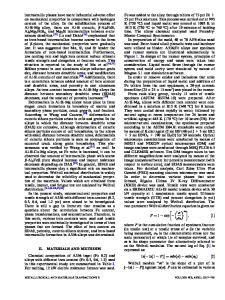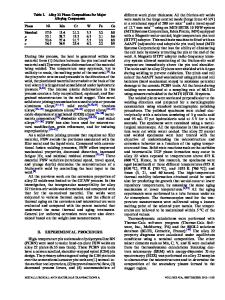Effect of the Metallic Aging on the Microstructure and Mechanical Properties of Titanium Alloy
- PDF / 947,071 Bytes
- 9 Pages / 432 x 648 pts Page_size
- 95 Downloads / 393 Views
Effect of the Metallic Aging on the Microstructure and Mechanical Properties of Titanium Alloy T.J. Sánchez-Rosas1*, J.D. Muñoz-Andrade1, M. Aguilar-Sánchez1, B. Vargas-Arista2, E. Garfias-García1 1
Universidad Autónoma Metropolitana Unidad -Azcapotzalco. Av. San Pablo No. 180. Col. Reynosa Tamaulipas México Distrito Federal, C.P. 02200.
2
Instituto Tecnológico de Tlalnepantla. División de Estudios de Posgrado e Investigación. Av. Instituto Tecnológico s/n. Col. La comunidad. Tlalnepantla de Baz Estado de México, C.P. 54070. *Email: [email protected]
ABSTRACT Different aging heat treatments were performed in a Titanium alloy using as aging media metallic baths in comparison to typical furnace aging. As a first step, a Duplex Aging (DA) consisted of solubilization followed by quenching to room temperature after aging heat treatment in different metallic baths (Zn, Sn and Bi). A second procedure was Alternative Aging (AA) which consisted of solubilization and direct aging inside three different aforementioned baths. Microstructural aging variations begins at half hour until 30 h at 550°C inside metallic bath of Zn, Sn or Bi. Both kinds of aging promoted a microstructural variation and so on microhardness values. Microstructural analysis by Optical Microscopy showed a structural refinement after AA treatment. The highest hardness value of 375 HVN was achieved in Alternative Aging with Zn bath, which was found to be dependent on laminar D phase refining. Moreover, after AA treatment for 0.5, 1, 2, 3, 4, 10 and 30 h at 550°C in the metallic bath of Zn and Sn, the results indicated similar hardness values in different times, resulting in the fastest kinetic for Sn metallic bath at 2 h compared to that 4 h in Zn metallic bath. The observed increase in micro-hardness is not very attractive, it is recommended to use large aging times in order to stabilize final spacing of microstructural features in AA treatment. INTRODUCTION Titanium alloys are widely used for highly loaded aerospace components that operate at low to moderately elevated temperatures, including both air frame and jet engine components and biomedical applications for example prosthetic hip, femur replacement of damaged or worn, surgical materials, etc. [1]. High specific strength and corrosion resistance are the reasons for rapid growth of the titanium industry, very closely to the market for commercial and military jet aircraft [2]. Titanium alloys are considered biocompatible, because they are not rejected by the human body, by developing porous coatings of compositions similar to bone, known as hydroxyapatite ceramics, it is possible to make titanium prostheses are bioactive; i.e. natural bone can grow over the coating [3].
2837 Downloaded from https://www.cambridge.org/core. North Carolina State University, on 28 Dec 2017 at 09:00:19, subject to the Cambridge Core terms of use, available at https://www.cambridge.org/core/terms. https://doi.org/10.1557/adv.2017.520
Titanium is a metal that undergoes allotropic transformation temperature of 88
Data Loading...











